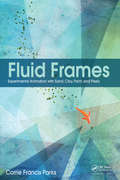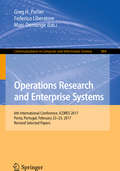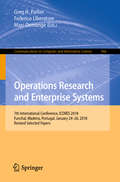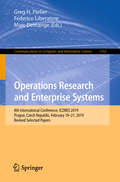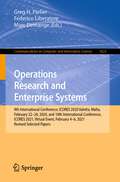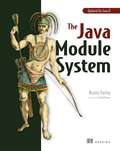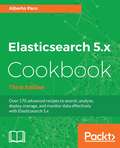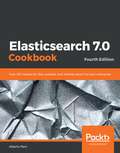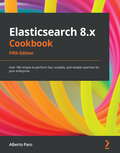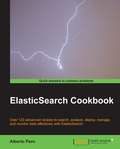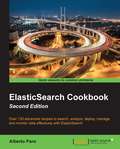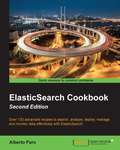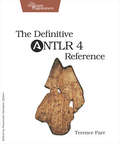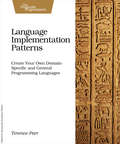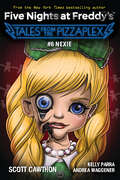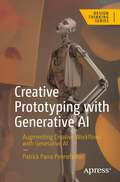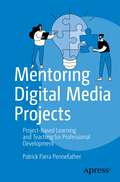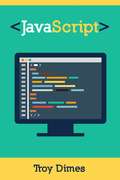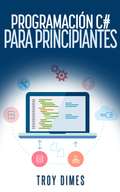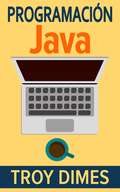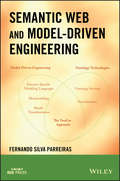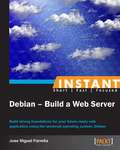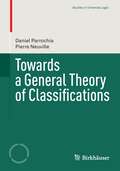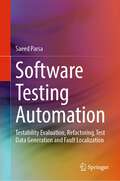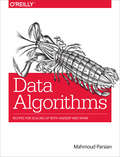- Table View
- List View
Fluid Frames: Experimental Animation with Sand, Clay, Paint, and Pixels
by Corrie Francis ParksOnce the realm of a few stalwart artists, animating with sand, clay, and wet paint is now accessible for all filmmakers with an experimental frame of mind. Created directly under the camera with frame-by-frame stopmotion, this "fluid frame animation" provides a completely unique visual world for animators. While pioneering animators such as Caroline Leaf, Alexander Petrov, and Ishu Patel paved the way, the availability of frame capture programs, compositing software and digital workflow is opening up new avenues of exploration for artists of all experience levels. This book will walk you through setting up your studio, choosing and working with your materials, and combining the physical under-the-camera production with digital compositing and effects to enhance your animation.· Firsthand advice from experimental animation veterans and rising stars in the field· Covers the digital aspects of experimental animation, including the latest techniques in After Effects CC· Tutorials and source files for under-the-camera approaches and After Effects enhancements on the book’s companion website In addition to the practical advice, you’ll find historical and contemporary examples of successful films, step-by-step tutorials for working under the camera and working with the footage digitally, and interviews and tips from artists who are currently pushing the boundaries in these experimental mediums. Stacked with information and images from over 30 artists, this book is an indispensable resource for both the student and professional wishing to get their hands dirty in an increasingly digital world.
Operations Research and Enterprise Systems: 6th International Conference, ICORES 2017, Porto, Portugal, February 23–25, 2017, Revised Selected Papers (Communications in Computer and Information Science #884)
by Greg H. Parlier Federico Liberatore Marc DemangeThis book constitutes revised selected papers from the 6th International Conference on Operations Research and Enterprise Systems, ICORES 2017, held in Porto, Portugal, in February 2017. The 15 papers presented in this volume were carefully reviewed and selected from a total of 90 submissions. They are organized in topical sections named: methodologies and technologies; and applications.
Operations Research and Enterprise Systems: 7th International Conference, ICORES 2018, Funchal, Madeira, Portugal, January 24–26, 2018, Revised Selected Papers (Communications in Computer and Information Science #966)
by Greg H. Parlier Federico Liberatore Marc DemangeThis book constitutes revised selected papers from the 7th International Conference on Operations Research and Enterprise Systems, ICORES 2018, held in Funchal, Madeira, Portugal, in January 2018.The 12 papers presented in this volume were carefully reviewed and selected from a total of 59 submissions. They are organized in topical sections named: methodologies and technologies; and applications.
Operations Research and Enterprise Systems: 8th International Conference, ICORES 2019, Prague, Czech Republic, February 19-21, 2019, Revised Selected Papers (Communications in Computer and Information Science #1162)
by Greg H. Parlier Federico Liberatore Marc DemangeThis book constitutes revised and selected papers from the 8th International Conference on Operations Research and Enterprise Systems, ICORES 2019, held in Prague, Czech Republic, in February 2019. The 9 extended and revised papers presented in this volume were carefully reviewed and selected from a total of 80 submissions. They were organized in topical sections named methodologies and technologies and applications.
Operations Research and Enterprise Systems: 9th International Conference, ICORES 2020, Valetta, Malta, February 22–24, 2020, and 10th International Conference, ICORES 2021, Virtual Event, February 4–6, 2021, Revised Selected Papers (Communications in Computer and Information Science #1623)
by Greg H. Parlier Federico Liberatore Marc DemangeThis book includes extended and revised versions of selected papers from the 9th and 10th edition of the International Conference on Operations Research and Enterprise Systems (ICORES 2020 and ICORES 2021). ICORES 2020 was held in Valletta, Malta from 22 – 24 of February 2020, and ICORES 2021 was held as an online event due to the Covid-19 pandemic, from 4 – 6 of February 2021.The 11 full papers included in this book were carefully reviewed and selected from 132 submissions. The ICORES 2020 and 2021 book contains extended and revised version of proceedings papers dealing with operations research and enterprise systems.
The Java Module System
by Nicolai ParlogSummaryJava's much-awaited "Project Jigsaw" is finally here! Java 11 includes a built-in modularity framework, and The Java Module System is your guide to discovering it. In this new book, you'll learn how the module system improves reliability and maintainability, and how it can be used to reduce tight coupling of system components.Foreword by Kevlin Henney.Purchase of the print book includes a free eBook in PDF, Kindle, and ePub formats from Manning Publications. You'll find registration instructions inside the print book.About the TechnologyPackaging code into neat, well-defined units makes it easier to deliver safe and reliable applications. The Java Platform Module System is a language standard for creating these units. With modules, you can closely control how JARs interact and easily identify any missing dependencies at startup. This shift in design is so fundamental that starting with Java 9, all core Java APIs are distributed as modules, and libraries, frameworks, and applications will benefit from doing the same.About the BookThe Java Module System is your in-depth guide to creating and using Java modules. With detailed examples and easy-to-understand diagrams, you'll learn the anatomy of a modular Java application. Along the way, you'll master best practices for designing with modules, debugging your modular app, and deploying to production.What's insideThe anatomy of a modular Java appBuilding modules from source to JARMigrating to modular JavaDecoupling dependencies and refining APIsHandling reflection and versioningCustomizing runtime imagesUpdated for Java 11About the ReaderPerfect for developers with some Java experience.About the AuthorNicolai Parlog is a developer, author, speaker, and trainer. His home is codefx.org. Table of ContentsPART 1 - Hello, modulesFirst piece of the puzzleAnatomy of a modular applicationDefining modules and their propertiesBuilding modules from source to JARRunning and debugging modular applicationsPART 2 - Adapting real-world projectsCompatibility challenges when moving to Java 9 or laterRecurring challenges when running on Java 9 or laterIncremental modularization of existing projectsMigration and modularization strategiesPART 3 - Advanced module system featuresUsing services to decouple modulesRefining dependencies and APIsReflection in a modular worldModule versions: What's possible and what's notCustomizing runtime images with jlinkPutting the pieces together
Elasticsearch 5.x Cookbook - Third Edition
by Alberto ParoOver 170 advanced recipes to search, analyze, deploy, manage, and monitor data effectively with Elasticsearch 5.x About This Book • Deploy and manage simple Elasticsearch nodes as well as complex cluster topologies • Write native plugins to extend the functionalities of Elasticsearch 5.x to boost your business • Packed with clear, step-by-step recipes to walk you through the capabilities of Elasticsearch 5.x Who This Book Is For If you are a developer who wants to get the most out of Elasticsearch for advanced search and analytics, this is the book for you. Some understanding of JSON is expected. If you want to extend Elasticsearch, understanding of Java and related technologies is also required. What You Will Learn • Choose the best Elasticsearch cloud topology to deploy and power it up with external plugins • Develop tailored mapping to take full control of index steps • Build complex queries through managing indices and documents • Optimize search results through executing analytics aggregations • Monitor the performance of the cluster and nodes • Install Kibana to monitor cluster and extend Kibana for plugins • Integrate Elasticsearch in Java, Scala, Python and Big Data applications In Detail Elasticsearch is a Lucene-based distributed search server that allows users to index and search unstructured content with petabytes of data. This book is your one-stop guide to master the complete Elasticsearch ecosystem. We'll guide you through comprehensive recipes on what's new in Elasticsearch 5.x, showing you how to create complex queries and analytics, and perform index mapping, aggregation, and scripting. Further on, you will explore the modules of Cluster and Node monitoring and see ways to back up and restore a snapshot of an index. You will understand how to install Kibana to monitor a cluster and also to extend Kibana for plugins. Finally, you will also see how you can integrate your Java, Scala, Python, and Big Data applications such as Apache Spark and Pig with Elasticsearch, and add enhanced functionalities with custom plugins. By the end of this book, you will have an in-depth knowledge of the implementation of the Elasticsearch architecture and will be able to manage data efficiently and effectively with Elasticsearch. Style and approach This book follows a problem-solution approach to effectively use and manage Elasticsearch. Each recipe focuses on a particular task at hand, and is explained in a very simple, easy to understand manner.
Elasticsearch 7.0 Cookbook: Over 100 recipes for fast, scalable, and reliable search for your enterprise, 4th Edition
by Alberto ParoSearch, analyze, and manage data effectively with Elasticsearch 7Key FeaturesExtend Elasticsearch functionalities and learn how to deploy on Elastic CloudDeploy and manage simple Elasticsearch nodes as well as complex cluster topologiesExplore the capabilities of Elasticsearch 7 with easy-to-follow recipesBook DescriptionElasticsearch is a Lucene-based distributed search server that allows users to index and search unstructured content with petabytes of data. With this book, you'll be guided through comprehensive recipes on what's new in Elasticsearch 7, and see how to create and run complex queries and analytics.Packed with recipes on performing index mapping, aggregation, and scripting using Elasticsearch, this fourth edition of Elasticsearch Cookbook will get you acquainted with numerous solutions and quick techniques for performing both every day and uncommon tasks such as deploying Elasticsearch nodes, integrating other tools to Elasticsearch, and creating different visualizations. You will install Kibana to monitor a cluster and also extend it using a variety of plugins. Finally, you will integrate your Java, Scala, Python, and big data applications such as Apache Spark and Pig with Elasticsearch, and create efficient data applications powered by enhanced functionalities and custom plugins.By the end of this book, you will have gained in-depth knowledge of implementing Elasticsearch architecture, and you'll be able to manage, search, and store data efficiently and effectively using Elasticsearch.What you will learnCreate an efficient architecture with ElasticsearchOptimize search results by executing analytics aggregationsBuild complex queries by managing indices and documentsMonitor the performance of your cluster and nodesDesign advanced mapping to take full control of index stepsIntegrate Elasticsearch in Java, Scala, Python, and big data applicationsInstall Kibana to monitor clusters and extend it for pluginsWho this book is forIf you’re a software engineer, big data infrastructure engineer, or Elasticsearch developer, you'll find this book useful. This Elasticsearch book will also help data professionals working in the e-commerce and FMCG industry who use Elastic for metrics evaluation and search analytics to get deeper insights for better business decisions. Prior experience with Elasticsearch will help you get the most out of this book.
Elasticsearch 8.x Cookbook: Over 180 recipes to perform fast, scalable, and reliable searches for your enterprise, 5th Edition
by Alberto ParoSearch, analyze, store and manage data effectively with Elasticsearch 8.xKey FeaturesExplore the capabilities of Elasticsearch 8.x with easy-to-follow recipesExtend the Elasticsearch functionalities and learn how to deploy on Elastic CloudDeploy and manage simple Elasticsearch nodes as well as complex cluster topologiesBook DescriptionElasticsearch is a Lucene-based distributed search engine at the heart of the Elastic Stack that allows you to index and search unstructured content with petabytes of data. With this updated fifth edition, you'll cover comprehensive recipes relating to what's new in Elasticsearch 8.x and see how to create and run complex queries and analytics. The recipes will guide you through performing index mapping, aggregation, working with queries, and scripting using Elasticsearch. You'll focus on numerous solutions and quick techniques for performing both common and uncommon tasks such as deploying Elasticsearch nodes, using the ingest module, working with X-Pack, and creating different visualizations. As you advance, you'll learn how to manage various clusters, restore data, and install Kibana to monitor a cluster and extend it using a variety of plugins. Furthermore, you'll understand how to integrate your Java, Scala, Python, and big data applications such as Apache Spark and Pig with Elasticsearch and create efficient data applications powered by enhanced functionalities and custom plugins. By the end of this Elasticsearch cookbook, you'll have gained in-depth knowledge of implementing the Elasticsearch architecture and be able to manage, search, and store data efficiently and effectively using Elasticsearch.What you will learnBecome well-versed with the capabilities of X-PackOptimize search results by executing analytics aggregationsGet to grips with using text and numeric queries as well as relationship and geo queriesInstall Kibana to monitor clusters and extend it for pluginsBuild complex queries by managing indices and documentsMonitor the performance of your cluster and nodesDesign advanced mapping to take full control of index stepsIntegrate Elasticsearch in Java, Scala, Python, and big data applicationsWho this book is forIf you're a software engineer, big data infrastructure engineer, or Elasticsearch developer, you'll find this Elasticsearch book useful. The book will also help data professionals working in e-commerce and FMCG industries who use Elastic for metrics evaluation and search analytics to gain deeper insights and make better business decisions. Prior experience with Elasticsearch will help you get the most out of this book.
ElasticSearch Cookbook
by Alberto ParoWritten in an engaging, easy-to-follow style, the recipes will help you to extend the capabilities of ElasticSearch to manage your data effectively.If you are a developer who implements ElasticSearch in your web applications, manage data, or have decided to start using ElasticSearch, this book is ideal for you. This book assumes that you've got working knowledge of JSON and Java
ElasticSearch Cookbook - Second Edition
by Alberto ParoIf you are a developer who implements ElasticSearch in your web applications and want to sharpen your understanding of the core elements and applications, this is the book for you. It is assumed that you've got working knowledge of JSON and, if you want to extend ElasticSearch, of Java and related technologies.
ElasticSearch Cookbook Second Edition
by Alberto Paro<P><P>Over 130 advanced recipes to search, analyze, deploy, manage, and monitor data effectively with ElasticSearch <P><P>About This Book <P><P>Deploy and manage simple ElasticSearch nodes as well as complex cluster topologies <P><P>Write native plugins to extend the functionalities of ElasticSearch to boost your business <P><P>Packed with clear, step-by-step recipes to walk you through the capabilities of ElasticSearch <P><P>Who This Book Is For <P><P>If you are a developer who implements ElasticSearch in your web applications and want to sharpen your understanding of the core elements and applications, this is the book for you. It is assumed that you’ve got working knowledge of JSON and, if you want to extend ElasticSearch, of Java and related technologies. <P><P>What You Will Learn <P><P>Make ElasticSearch work for you by choosing the best cloud topology and powering it with plugins <P><P>Develop tailored mapping to take full control of index steps <P><P>Build complex queries through managing indices and documents <P><P>Optimize search results through executing analytics aggregations <P><P>Manage rivers (SQL, NoSQL, and web-based) to synchronize and populate cross-source data <P><P>Develop web interfaces to execute key tasks <P><P>Monitor the performance of the cluster and nodes <P><P>In Detail <P><P>This book will guide you through the complete ElasticSearch ecosystem. From choosing the correct transport layer and communicating with the server to creating and customizing internal actions, you will develop an in-depth knowledge of the implementation of the ElasticSearch architecture. <P><P>After creating complex queries and analytics, mapping, aggregation, and scripting, you will master the integration of ElasticSearch's functionality in user-facing applications and take your knowledge one-step further by building custom plugins, developing tailored mapping, executing powerful analytics, and integrating with Python and Java applications.
The Definitive ANTLR 4 Reference (Oreilly And Associate Ser.)
by Terence ParrProgrammers run into parsing problems all the time. Whether it's a data format like JSON, a network protocol like SMTP, a server configuration file for Apache, a PostScript/PDF file, or a simple spreadsheet macro language--ANTLR v4 and this book will demystify the process. ANTLR v4 has been rewritten from scratch to make it easier than ever to build parsers and the language applications built on top. This completely rewritten new edition of the bestselling Definitive ANTLR Reference shows you how to take advantage of these new features.Build your own languages with ANTLR v4, using ANTLR's new advanced parsing technology. In this book, you'll learn how ANTLR automatically builds a data structure representing the input (parse tree) and generates code that can walk the tree (visitor). You can use that combination to implement data readers, language interpreters, and translators. You'll start by learning how to identify grammar patterns in language reference manuals and then slowly start building increasingly complex grammars. Next, you'll build applications based upon those grammars by walking the automatically generated parse trees. Then you'll tackle some nasty language problems by parsing files containing more than one language (such as XML, Java, and Javadoc). You'll also see how to take absolute control over parsing by embedding Java actions into the grammar. You'll learn directly from well-known parsing expert Terence Parr, the ANTLR creator and project lead. You'll master ANTLR grammar construction and learn how to build language tools using the built-in parse tree visitor mechanism. The book teaches using real-world examples and shows you how to use ANTLR to build such things as a data file reader, a JSON to XML translator, an R parser, and a Java class->interface extractor. This book is your ticket to becoming a parsing guru!What You Need:ANTLR 4.0 and above. Java development tools. Ant build system optional(needed for building ANTLR from source)
Language Implementation Patterns: Create Your Own Domain-Specific and General Programming Languages
by Terence ParrLearn to build configuration file readers, data readers, model-driven code generators, source-to-source translators, source analyzers, and interpreters. You don't need a background in computer science--ANTLR creator Terence Parr demystifies language implementation by breaking it down into the most common design patterns. Pattern by pattern, you'll learn the key skills you need to implement your own computer languages.Knowing how to create domain-specific languages (DSLs) can give you a huge productivity boost. Instead of writing code in a general-purpose programming language, you can first build a custom language tailored to make you efficient in a particular domain.The key is understanding the common patterns found across language implementations. Language Design Patterns identifies and condenses the most common design patterns, providing sample implementations of each.The pattern implementations use Java, but the patterns themselves are completely general. Some of the implementations use the well-known ANTLR parser generator, so readers will find this book an excellent source of ANTLR examples as well. But this book will benefit anyone interested in implementing languages, regardless of their tool of choice. Other language implementation books focus on compilers, which you rarely need in your daily life. Instead, Language Design Patterns shows you patterns you can use for all kinds of language applications.You'll learn to create configuration file readers, data readers, model-driven code generators, source-to-source translators, source analyzers, and interpreters. Each chapter groups related design patterns and, in each pattern, you'll get hands-on experience by building a complete sample implementation. By the time you finish the book, you'll know how to solve most common language implementation problems.
Nexie: An AFK Book (Five Nights At Freddy's)
by Kelly Parra Scott Cawthon Andrea WaggenerFive Nights at Freddy's fans won't want to miss this collection of three chilling stories that will haunt even the bravest player...Can you keep a secret? . . . Astrid doesn’t tell anyone about the strange things her Buddytronic doll has been up to. Kara convinces a Pizzaplex employee no one will know if he lets her spend a little more time in the VR attraction. And a Fazbear Entertainment engineer’s custom project has surprises in store for anyone who encounters it. But in the world of Five Nights at Freddy’s, secrets never stay hidden for long . . .In this sixth volume, Five Nights at Freddy's creator Scott Cawthon spins three sinister novella-length tales from uncharted corners of his series' canon. In the world of Five Nights at Freddy's, everything comes with a price to pay.Readers beware: This collection of terrifying tales is enough to rattle even the most hardened Five Nights at Freddy's fans.
Creative Prototyping with Generative AI: Augmenting Creative Workflows with Generative AI (Design Thinking)
by Patrick Parra PennefatherReimagine different generative AI as useful creative prototyping tools that can be used to augment your own creative process and projects. Gain a deeper understanding of how generative AI can elevate your creative future. You will acquire a comprehensive understanding of how AI works, uncover tools that can enhance your AI interactions, learn how to extract maximum potential from AI-produced content, and experiment with methods for assessing, refining, and boosting the content to transform your creative projects. You'll also explore how creative professionals from varied disciplines are employing generative AI in their workflows to produce distinctive contributions to the world. Each chapter provides examples of how designers and other creative individuals can utilize these technological wonders, adopting various prototyping techniques to fast-track and optimize design processes and workflows. Creators from all disciplines can tap into the vast capabilities and benefits of generative AI, enabling them to rapidly experiment and prototype their ideas.You Will Learn:Understand how generative AI can support your own creative processLearn tools to get the most out of text-text, text-image, and text-video generative AIAugment your design practices using generative AIDraw inspiration from AI generated content to create unique creative workImprove and streamline creatives processes and workflowsWho This Book Is ForDigital media professionals who want to access off-the shelf creative tools to improve and accelerate their creativity and workflow.Designers and engineers who are looking at novel ways to improve their prototyping and testing processes.Students who want to use AI to rapidly generate ideas to support them in prototyping assignments.Instructors interested in pointing their students to a variety of accessible AI resources to manage their own creativity.
Mentoring Digital Media Projects: Project-Based Learning and Teaching for Professional Development
by Patrick Parra PennefatherMentoring is often a crucial, yet informal part of an organization’s best practices and skill development, whether targeted towards a team lead, project manager, designer, developer or a valued senior team member. This book provides practical strategies and methodologies for professionals to mentor others to successfully develop and deliver digital media projects across different types of settings.Many professionals working with teams in the digital media industry (games, web development, XR, IoT, mobile) are drawn to teaching others, but may not know how or where to start. Many might be a subject expert but may not have the structure and skills in place to be able to teach others effectively in workplace and institutional settings. This handbook will give professionals a guide on how to mentor junior designers, developers and other learners in formal and informal learning environments. Mentoring Digital Media Projects offers the right tools and strategies to use in digital media and emerging tech projects for you to better guide junior team members What You'll Learn Understand the difference between mentoring and teachingDesign thinking strategies to better identify where, when and how you can help and mentor othersBuild mentoring pipelines, end-to end, especially in post-secondary learning environmentsCreate emerging technology projects with teams Who This Book Is For Digital media professionals (game, web development, XR, mobile, IoT, etc.) who have experience working in teams in their specific discipline and who want to mentor others.
JavaScript Una Guía de Aprendizaje para el Lenguaje de Programación JavaScript
by Andrés Parraud Troy DimesJavaScript es un lenguaje de programación de computadoras dinámico utilizado habitualmente en navegadores web para controlar el comportamiento de páginas web e interactuar con los usuarios. Permite comunicación asincrónica y puede actualizar partes de una página web o incluso reemplazar completamente su contenido. Verás que JavaScript es utilizado para mostrar información de fecha y hora, ejecutar animaciones en un sitio web, validar formularios, sugerir resultados mientras el usuario escribe en un cuadro de búsqueda y más. JavaScript está siendo usado cada vez más... A pesar de que JavaScript es, por mucho, el lenguaje de programación de cliente más popular actualmente en uso, puede ser usado -y, de hecho, lo es- también en el servidor. Node.js, Meteor, Wakanda, CouchDB y MongoDB son sólo unos pocos ejemplos de lugares donde encontrarás y serás capaz de usar JavaScript en el servidor. El tiempo que inviertas en aprender JavaScript puede ser doblemente rendidor, ya que JavaScript sigue expandiéndose por cada vez más áreas de la computación. Aprende los fundamentos del lenguaje de programación JavaScript Ya sea que planees usar JavaScript en el lado del cliente en un navegador web, en el lado del servidor, o ambos, necesitas aprender los fundamentos del lenguaje. Esto es lo que te proporcionará este libro. Cuando termines de leerlo, te sentirás cómodo y confiado programando en Lenguaje JavaScript. Estas son algunas cosas que aprenderás cuando leas este libro: Dónde puede usarse JavaScript Cómo configurar tu computadora para programar en JavaScript cómoda y fácilmente Qué herramientas debes tener cuando programes en JavaScript Los fundamentos del HTML... Qué son las variables y cómo usarlas Cómo manejar números y realizar operaciones matemáticas Cómo y cuándo usar condicionales Qué funciones hay, por qué son tan útiles y
Programación C# para Principiantes
by Andrés Parraud Troy DimesComo agradecimiento por leer Programación C# para Principiantes, quiero darte una copia gratuita de "7 Little-Known C# Programming Tricks." ("7 Trucos de Programación C# Poco Conocidos"). Para descargar tu copia, visita: http://www.linuxtrainingacademy.com/7-tricks
Programación Java - Una Guía para Principiantes para Aprender Java Paso a Paso
by Andrés Parraud Troy DimesFecha de Publicación: 16 de Enero de 2015 Aprenda uno de los lenguajes de programación de computadoras más extensamente usado actualmente. Java es uno de los lenguajes de programación más extensamente usados actualmente. Una vez que aprendas cómo porgramar en Java, podrás crear programas de aplicación que funcionen en servidores, computadoras, tablets, teléfonos, reproductores Blu-Ray y más. ¡Escribe una vez, corre en todas partes! También, si quieres estar seguro que tu programa se comporta siempre igual independientemente del sistema operativo bajo el que esté corriendo, la filosofía Java "Escrito una vez, corre en todas partes" es para ti. Java fue diseñado para ser independiente de su plataforma, permitiéndote crear aplicaciones que corren en gran variedad de sistemas operativos, incluyendo Windows, Mac, Solaris y Linux. Esto es lo que aprenderás... Cómo preparar tu computadora para programar en Java (Fotos de pantalla incluidas). Convenciones de nombres de archivo Java. Cómo trabajar con varios tipos de datos, incluyendo enteros, de coma flotante, caracteres y booleanos. Qué variables hay y cuándo usarlas. Cómo efectuar operaciones matemáticas en Java. Tomar decisiones en tu programa en base a comparaciones. Otras formas de control de flujo de tu programa. Cómo manipular datos de texto. Todo sobre matrices - cómo crearlas, cuándo usarlas y más. Varias formas de efectuar las mismas acciones en tus programas sin repetirte. 3 tipos de bucles. Conceptos y técnicas de programación orientada a objetos, incluyendo clases, modificadores, métodos, herencia y polimorfismo. Formas de manejar con gracia errores que pueden ocurrir cuando alguien usa tus programas. Y más... Ejercicios prácticos incluidos que harán que Java haga "clic" en tu cabeza. Incluye un eje
Semantic Web and Model-Driven Engineering
by Fernando S. ParreirasThe next enterprise computing era will rely on the synergy between both technologies: semantic web and model-driven software development (MDSD). The semantic web organizes system knowledge in conceptual domains according to its meaning. It addresses various enterprise computing needs by identifying, abstracting and rationalizing commonalities, and checking for inconsistencies across system specifications. On the other side, model-driven software development is closing the gap among business requirements, designs and executables by using domain-specific languages with custom-built syntax and semantics. It focuses on using modeling languages as programming languages.Among many areas of application, we highlight the area of configuration management. Consider the example of a telecommunication company, where managing the multiple configurations of network devices (routers, hubs, modems, etc.) is crucial. Enterprise systems identify and document the functional and physical characteristics of network devices, and control changes to those characteristics. Applying the integration of semantic web and model-driven software development allows for(1) explicitly specifying configurations of network devices with tailor-made languages,(2) for checking the consistency of these specifications(3) for defining a vocabulary to share device specifications across enterprise systems. By managing configurations with consistent and explicit concepts, we reduce cost and risk, and enhance agility in response to new requirements in the telecommunication area.This book examines the synergy between semantic web and model-driven software development. It brings together advances from disciplines like ontologies, description logics, domain-specific modeling, model transformation and ontology engineering to take enterprise computing to the next level.
Instant Debian: Build a Web Server
by Jose Miguel ParrellaFilled with practical, step-by-step instructions and clear explanations for the most important and useful tasks. A concise guide full of step-by-step recipes to teach you how to install and configure a Debian web server.This is an ideal book if you are an administrator on a Development Operations team or infrastructure management, who is passionate about Linux and their Web applications but have no previous experience with Debian or APT-based systems.
Towards a General Theory of Classifications
by Daniel Parrochia Pierre NeuvilleThis book is an essay on the epistemology of classifications. Its main purpose is not to provide an exposition of an actual mathematical theory of classifications, that is, a general theory which would be available to any kind of them: hierarchical or non-hierarchical, ordinary or fuzzy, overlapping or non-overlapping, finite or infinite, and so on, establishing a basis for all possible divisions of the real world. For the moment, such a theory remains nothing but a dream. Instead, the authors essentially put forward a number of key questions. Their aim is rather to reveal the "state of art" of this dynamic field and the philosophy one may eventually adopt to go further. To this end they present some advances made in the course of the last century, discuss a few tricky problems that remain to be solved, and show the avenues open to those who no longer wish to stay on the wrong track. Researchers and professionals interested in the epistemology and philosophy of science, library science, logic and set theory, order theory or cluster analysis will find this book a comprehensive, original and progressive introduction to the main questions in this field.
Software Testing Automation: Testability Evaluation, Refactoring, Test Data Generation and Fault Localization
by Saeed ParsaThis book is about the design and development of tools for software testing. It intends to get the reader involved in software testing rather than simply memorizing the concepts. The source codes are downloadable from the book website. The book has three parts: software testability, fault localization, and test data generation. Part I describes unit and acceptance tests and proposes a new method called testability-driven development (TsDD) in support of TDD and BDD. TsDD uses a machine learning model to measure testability before and after refactoring. The reader will learn how to develop the testability prediction model and write software tools for automatic refactoring. Part II focuses on developing tools for automatic fault localization. This part shows the reader how to use a compiler generator to instrument source code, create control flow graphs, identify prime paths, and slice the source code. On top of these tools, a software tool, Diagnoser, is offered to facilitate experimenting with and developing new fault localization algorithms. Diagnoser takes a source code and its test suite as input and reports the coverage provided by the test cases and the suspiciousness score for each statement. Part III proposes using software testing as a prominent part of the cyber-physical system software to uncover and model unknown physical behaviors and the underlying physical rules. The reader will get insights into developing software tools to generate white box test data.
Data Algorithms
by Mahmoud ParsianIf you are ready to dive into the MapReduce framework for processing large datasets, this practical book takes you step by step through the algorithms and tools you need to build distributed MapReduce applications with Apache Hadoop or Apache Spark. Each chapter provides a recipe for solving a massive computational problem, such as building a recommendation system. You'll learn how to implement the appropriate MapReduce solution with code that you can use in your projects.Dr. Mahmoud Parsian covers basic design patterns, optimization techniques, and data mining and machine learning solutions for problems in bioinformatics, genomics, statistics, and social network analysis. This book also includes an overview of MapReduce, Hadoop, and Spark.Topics include:Market basket analysis for a large set of transactionsData mining algorithms (K-means, KNN, and Naive Bayes)Using huge genomic data to sequence DNA and RNANaive Bayes theorem and Markov chains for data and market predictionRecommendation algorithms and pairwise document similarityLinear regression, Cox regression, and Pearson correlationAllelic frequency and mining DNASocial network analysis (recommendation systems, counting triangles, sentiment analysis)
